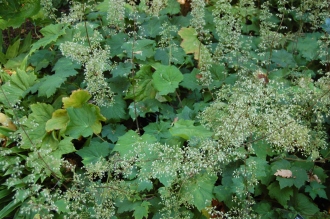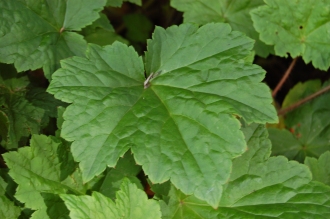Position: Full sun to partial shade
Soil: Moist, well drained soil
Flowering period: Summer and autumn
Eventual Height: 50cm
Eventual Spread: 50cm
Hardiness: 4a, 4b, 5a, 5b, 6a, 6b, 7a, 7b, 8a, 8b, 9a, 9b
Family: Saxifragaceae
Heuchera villosa is an evergreen perennial with a clump forming habit. Its foliage is mostly basal with chordate leaves that are sharply lobed at the edges and has has hairy leaf petioles and flower stems. Its inflorescence is composed of hermaphroditic, small, tubular white flowers that form open panicles making the flowers appear to hover above the leaves.
Heuchera villosa, commonly known as Hairy Alumroot is native to parts of central and eastern North America and is usually found growing on shaded slopes in damp wooded areas.
The etymological root of the binomial name Heuchera was named for Johann Heinrich von Heucher, the 18th century professor of medicine and botanist at Wittenberg, Germany. Villosa is from the Latin meaning ‘velvet’.
The landscape architect may find Heuchera villosa useful as a robust and effective ground cover plant which is drought resistant. This plant is suited to mass plantings on slopes or banks where low maintenance is required, it is also resistant to deer browsing. This plant was located in the 2011 Serpentine Gallery Pavilion designed by Peter Zumpthor with planting by Piet Oudlf.
The Royal Horticultural Society gave the cultivar Heuchera villosa ‘Palace Purple’ their Award of Garden Merit but this was rescinded due to the market being flooded by inferior seedlings that did not conform to the original specimens.
Heuchera villosa will tolerate varied soil conditions; it will be happy at neutral pH levels, in loam or sand based soils in a sheltered or exposed location facing any aspect. The woody rootstock tends to lift out of the ground so it may be mulched annually or lifted and replanted.
Ecologically, Heuchera villosa will attract pollinating insects such as butterflies and honey bees however, as this plant is not native to this continent these associations may not be prolific.
Heuchera villosa requires little maintenance. Unsightly flower heads and foliage may be removed if required or to encourage further flowering. Large clumps may be divided in spring or autumn.
![]()
Landscape Architecture







Leave a comment